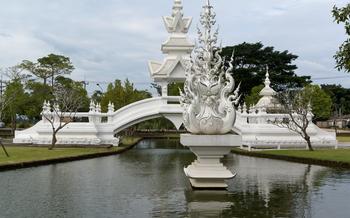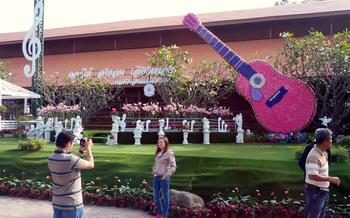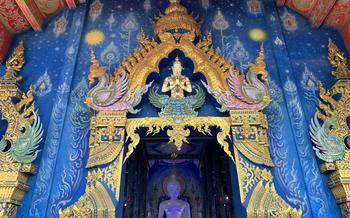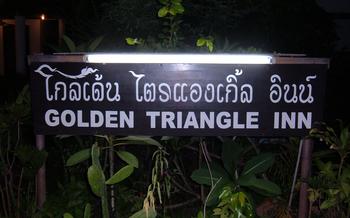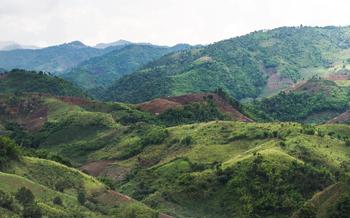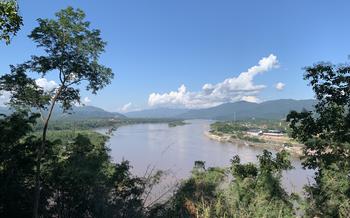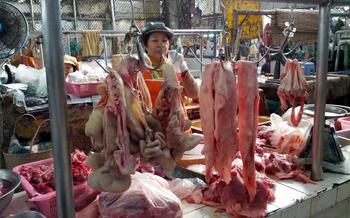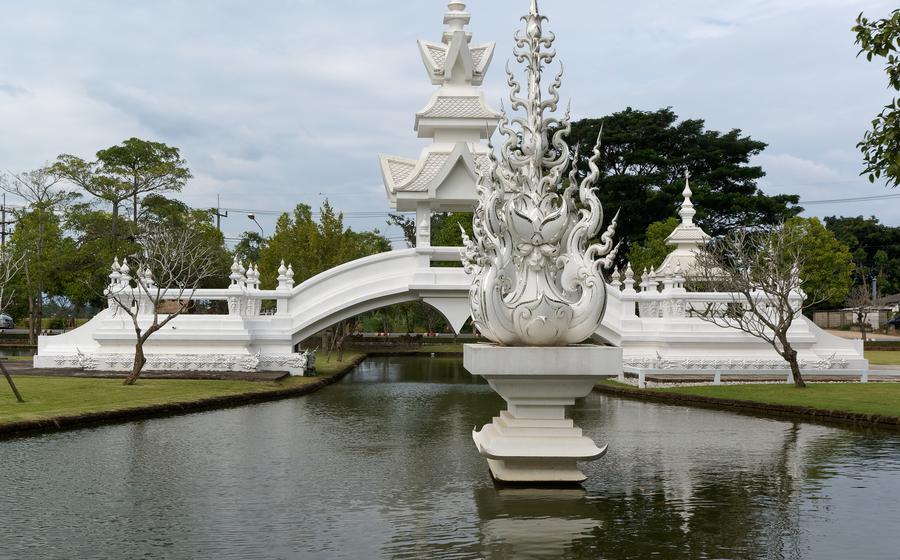
Lahu Village
- A Journey to Lahu Village: Unveiling a Cultural Tapestry
- Stepping into the Village: A Warm Welcome Awaits
- Exploring Lahu Traditions: A Window into Their Heritage
- Lahu Cuisine: Tantalizing Flavors of the Mountains
- Community Engagement: Interacting with the Lahu People
- Nature's Embrace: Exploring the Village Surroundings
- Accommodations: Resting amidst Nature's Serenity
- Transportation: Reaching the Lahu Village
- Sustainable Tourism: Treading Lightly in Lahu Lands
- Budgeting for a Memorable Experience
- Safety Tips: Ensuring a Smooth and Secure Visit
- Photography Etiquette: Capturing Moments Respectfully
- Language Barriers: Bridging the Communication Gap
- Souvenirs: Preserving Memories of the Lahu Experience
- Insider Tip: Unveiling Hidden Gems
A Journey to Lahu Village: Unveiling a Cultural Tapestry
In the heart of Chiang Rai, nestled amidst picturesque mountains and verdant valleys, lies the Lahu Village, an enchanting haven that beckons travelers seeking authentic cultural experiences. The Lahu people, an ethnic minority group with a rich history, have preserved their unique traditions and way of life, creating a vibrant tapestry that captivates visitors from around the world.
The Lahu people, also known as the Muser or Akha, migrated from southern China to the mountainous regions of Thailand centuries ago. They brought with them a wealth of traditions, customs, and beliefs that have been passed down through generations. Today, the Lahu population in Thailand is estimated to be around 120,000, with a significant number residing in Chiang Rai and its surrounding areas.
The Lahu Village, located approximately 60 kilometers northeast of Chiang Rai city, is a living testament to the enduring spirit of this ethnic group. It is easily accessible by road, making it a popular destination for day trips or extended stays. The village is nestled amidst lush greenery, offering visitors a chance to immerse themselves in the beauty of nature while exploring the rich cultural heritage of the Lahu people.
The best time to visit the Lahu Village is during the cool season, from November to February, when the weather is pleasant and ideal for outdoor activities. However, the village welcomes visitors throughout the year, as each season brings its own unique charms and experiences. Whether you're seeking cultural immersion, breathtaking scenery, or a chance to connect with nature, the Lahu Village is a destination that promises an unforgettable and enriching journey.
Stepping into the Village: A Warm Welcome Awaits
Upon arriving at the Lahu village, a sense of tranquility envelops you. The villagers greet you with warm smiles and welcoming gestures, making you feel like a long-lost friend. The village exudes an aura of simplicity and authenticity, where time seems to stand still.
Observing local customs and etiquette is essential to show respect for the Lahu culture. Dress modestly and avoid revealing clothing. When entering a house, remove your shoes and greet the elders with a slight bow. A local guide can provide valuable insights into the village's traditions and help you navigate cultural nuances.
Finding a local guide is recommended to enhance your experience. They can share stories about the village's history, customs, and beliefs. Guides can also arrange for unique experiences such as traditional dance performances or cooking demonstrations.
Appropriate attire for visiting the village is recommended. While the dress code is relaxed, it's advisable to wear comfortable clothing that respects the local culture. Avoid wearing shorts or tank tops, and opt for long pants or skirts that cover your knees.
Exploring Lahu Traditions: A Window into Their Heritage
The Lahu people have preserved their rich cultural traditions and heritage despite modernization's encroachment. Their traditional attire, known as "Lahu yuo," is a captivating sight, with women wearing vibrant skirts and embroidered blouses, while men don black or indigo tunics and trousers.
Witnessing handicraft demonstrations in the village is a mesmerizing experience. Skilled craftspeople showcase their artistry, creating intricate textiles, bamboo crafts, and silver jewelry using traditional techniques passed down through generations.
Ancient rituals and ceremonies hold a significant place in Lahu culture. Visitors may have the opportunity to witness these sacred events, gaining insights into the Lahu's spiritual beliefs and practices.
Lahu music and dance performances are vibrant expressions of their culture. The rhythmic beats of gongs and drums fill the air as villagers perform graceful dances, adorned in traditional costumes. These performances showcase the Lahu's deep connection to their heritage and their love for the performing arts.
Lahu Cuisine: Tantalizing Flavors of the Mountains
Immerse yourself in the culinary delights of the Lahu people, whose cuisine is as diverse and flavorful as their culture. Begin your gastronomic journey with "khao soi," a delectable rice noodle soup that blends the richness of coconut milk with the warmth of curry spices. Savor the unique flavors of "larb," a zesty minced meat salad bursting with the freshness of herbs and the tang of lime. Don't miss the chance to try "gaeng daeng," a fiery red curry that showcases the perfect balance of heat and aromatic spices.
Venture into the realm of street food and indulge in crispy "khanom jeen," fermented rice noodles served with a variety of flavorful dipping sauces. Satisfy your sweet cravings with "khanom krok," delicate coconut pancakes that melt in your mouth. For a taste of local produce, explore the vibrant markets and sample exotic fruits and vegetables unique to the region.
Enhance your culinary experience by participating in a cooking class, where you'll learn the secrets of Lahu cuisine firsthand. Discover the art of blending spices, balancing flavors, and creating dishes that are both delicious and visually appealing. Return home with a newfound appreciation for Lahu cuisine and the ability to recreate these culinary masterpieces in your own kitchen.
Community Engagement: Interacting with the Lahu People
A visit to the Lahu village is not merely about observing their customs from a distance; it's about immersing yourself in their vibrant community and fostering meaningful connections. Volunteering opportunities abound, allowing you to give back while gaining invaluable insights into their way of life. Engage in teaching English to the children, assist with community development projects, or lend a hand in agricultural activities.
Local markets offer a rich tapestry of authentic Lahu products, from intricately woven textiles and handmade crafts to fresh produce and traditional snacks. Stroll through the vibrant stalls, interact with the friendly vendors, and discover unique treasures that capture the essence of the Lahu culture.
To enhance your communication, learn a few basic Lahu phrases. A simple greeting, a word of thanks, or an attempt to converse in their language will be warmly received and foster a deeper connection. Non-verbal cues and gestures can also bridge the language barrier, conveying messages of respect and curiosity.
Cultural exchange is a two-way street. Share stories of your homeland, ask questions about their traditions, and engage in lively discussions. The Lahu people are eager to share their rich heritage and learn about yours, creating a mutually enriching experience.
Nature's Embrace: Exploring the Village Surroundings
Venture beyond the village center to immerse yourself in the breathtaking natural beauty that surrounds the Lahu community. Embark on invigorating trekking trails that lead you through lush forests, past cascading waterfalls, and offer panoramic views of the rolling hills. Keep your eyes peeled for exotic wildlife, including colorful birds, nimble monkeys, and even the occasional elephant. Birdwatching enthusiasts will delight in the diverse avifauna that calls this region home, making it a haven for birdwatching enthusiasts. Capture the essence of this natural paradise through nature photography, preserving the memories of your adventure in stunning images.
Accommodations: Resting amidst Nature's Serenity
When night falls upon the Lahu Village, a serene tranquility envelops the surroundings, inviting weary travelers to seek solace and rejuvenation. A range of accommodation options awaits, each offering a unique blend of comfort and authenticity.
For an immersive experience, opt for a homestay, where you can reside alongside local families, gaining insights into their daily lives and traditions. These homestays provide basic amenities while immersing you in the warmth and hospitality of the Lahu people.
Eco-friendly lodging options are available for those seeking a sustainable retreat. These accommodations prioritize harmony with the environment, utilizing renewable energy sources and incorporating eco-friendly practices. Nestled amidst verdant landscapes, these lodgings offer a chance to reconnect with nature while minimizing your ecological footprint.
Amenities and facilities vary depending on the chosen accommodation. Some homestays provide shared bathrooms and communal spaces, while others offer private rooms with en-suite facilities. Eco-lodges often feature solar-powered lighting, rainwater harvesting systems, and organic gardens, showcasing their commitment to sustainable living.
Advance booking is recommended, especially during peak tourist seasons, to secure your preferred accommodation and avoid any last-minute disappointments. Embrace the tranquility of the Lahu Village, where nature's embrace and warm hospitality blend seamlessly, creating a sanctuary of peace and rejuvenation.
Transportation: Reaching the Lahu Village
Reaching the Lahu village requires a combination of transportation options. From major cities like Bangkok or Chiang Mai, you can take a flight or a bus to Chiang Rai, the nearest city to the village. Once in Chiang Rai, local transportation options such as songthaews (shared taxis) or tuk-tuks can be used to travel to the village. These modes of transport are affordable and widely available, ensuring a smooth journey to your destination.
For a more personalized and comfortable experience, hiring a private vehicle is recommended. This option offers flexibility and allows you to explore the surrounding areas at your own pace. Several car rental companies operate in Chiang Rai, providing a range of vehicles to suit different needs and budgets. Make sure to book in advance, especially during peak tourist season, to avoid any inconvenience.
When driving to the village, remember to follow the recommended routes to ensure a hassle-free journey. The roads are generally well-maintained, but it's essential to exercise caution, especially on winding mountain roads. With careful planning and consideration, getting to the Lahu village is a straightforward and enjoyable part of your adventure.
Sustainable Tourism: Treading Lightly in Lahu Lands
As travelers, it's our responsibility to minimize our impact on the environment and respect the customs of the Lahu people. Sustainable tourism practices ensure that our visit benefits the community while preserving its natural beauty and cultural heritage.
-
Reduce your environmental footprint: Opt for eco-friendly accommodation, use reusable water bottles, and avoid single-use plastics.
-
Support local businesses: Buy souvenirs from local artisans, dine at family-run restaurants, and hire local guides.
-
Respect local customs: Dress modestly, ask permission before taking photos, and refrain from touching religious objects.
-
Give back to the community: Volunteer your time at a local school or participate in community development projects.
By embracing sustainable tourism, we can help preserve the unique charm of the Lahu village for future generations.
Budgeting for a Memorable Experience
A trip to Lahu Village should not be a significant financial burden. Accommodation costs range from $10 to $30 per night for guesthouses and homestays, while meals can be enjoyed for around $5 to $10 per person. Activities such as trekking, guided tours, and cooking classes typically fall between $10 and $20. Transportation to and from Chiang Rai can be arranged for approximately $20 to $30.
For budget-conscious travelers, there are several ways to save money. Consider visiting during the shoulder seasons (May-June and September-October) to take advantage of off-season discounts and promotions. Look for budget guesthouses or homestays that offer basic but comfortable accommodations. Take advantage of free activities like hiking and birdwatching, and opt for local markets instead of restaurants for affordable meals.
When it comes to bargaining, be polite and respectful. Start by offering a reasonable price and be prepared to walk away if the seller is not willing to negotiate. Remember, the goal is to get a fair deal, not to take advantage of the locals.
With careful planning and a bit of flexibility, it is possible to have a memorable and enriching experience in Lahu Village without breaking the bank.
Safety Tips: Ensuring a Smooth and Secure Visit
Navigating a new destination, especially in a foreign country, requires prioritizing personal safety. When visiting Lahu Village, here are essential tips to ensure a smooth and secure experience:
-
General Safety Precautions:
-
Maintain general awareness of your surroundings and avoid walking alone at night.
- Keep your valuables, including passport and money, securely hidden or in a safe place.
- Be cautious of pickpockets, especially in crowded areas.
-
Avoid wearing expensive jewelry or clothing that may attract unwanted attention.
-
Recommended Vaccinations and Health Measures:
-
Consult with a healthcare professional before your trip to determine necessary vaccinations, such as Hepatitis A and B, Typhoid, and Japanese Encephalitis.
- Pack a basic first-aid kit with essential medications and supplies.
-
Stay hydrated by drinking plenty of clean water, especially during hot weather.
-
Avoiding Common Tourist Traps:
-
Be wary of individuals offering unsolicited services or tours. Always inquire at the village's official tourist center or through a reputable tour operator.
-
Be cautious when purchasing souvenirs, as some vendors may sell counterfeit or overpriced items.
-
Solo Traveler Safety Advice:
-
If traveling alone, inform your family or friends of your itinerary and check in regularly.
- Avoid accepting invitations from strangers and be cautious when venturing into isolated areas.
- Consider joining group tours or activities to meet fellow travelers and enhance safety.
Photography Etiquette: Capturing Moments Respectfully
Photography is a wonderful way to capture the essence of a place and its people. However, it's important to be mindful of cultural sensitivities and respect the privacy of the Lahu people.
Before taking any photos, always ask permission from the individuals you want to photograph. This shows respect and ensures that you're not intruding on their privacy.
Avoid taking intrusive or disrespectful photos, especially of women or children. Refrain from using flash photography, as it can be startling and disruptive.
Support local photographers by purchasing their work. This not only helps to sustain their livelihoods but also ensures that the images you bring home are of high quality and taken with respect.
To capture stunning images of the village and its people, try to arrive early in the morning or late in the afternoon when the light is soft and golden. Use a wide-angle lens to capture the vast landscapes and a telephoto lens for close-up portraits.
Language Barriers: Bridging the Communication Gap
Navigating a foreign land with a different language can be challenging, but with a little preparation and open-mindedness, you can easily bridge the communication gap and connect with the Lahu people. Start by learning a few basic Thai phrases, such as "hello," "thank you," and "goodbye." These gestures of respect will go a long way in showing your willingness to engage with the locals.
If you want to delve deeper into conversations and gain a more profound understanding of the Lahu culture, consider hiring a translator or guide. They can help facilitate communication, provide insights into local customs, and ensure that you don't miss out on any important cultural nuances.
Non-verbal cues and gestures are also powerful tools for communication, especially when words fail. A smile, a nod, or a thumbs-up can convey friendliness and understanding. Be patient and don't get discouraged if you encounter misunderstandings. Remember, communication is a two-way street, and the Lahu people are just as eager to connect with you as you are with them.
Souvenirs: Preserving Memories of the Lahu Experience
A visit to the Lahu village is an immersive cultural experience that leaves an imprint on the heart. As you bid farewell to this enchanting place, you may wish to take home a piece of its essence. Souvenirs from the village offer a tangible way to preserve your memories and support the local economy.
Handicrafts and Textiles: Lahu artisans create exquisite handicrafts and textiles that showcase their rich cultural heritage. From intricately woven baskets and colorful fabrics to hand-carved wooden sculptures, these items are a testament to their skill and creativity.
Local Produce: The Lahu people are known for their unique culinary traditions. Consider bringing home some locally produced coffee, tea, or spices to recreate the flavors you've tasted during your visit.
Ethical Souvenir Shopping: When purchasing souvenirs, it's essential to support local artisans and businesses. Look for shops that employ fair trade practices and ensure that the products you buy are made by the people of the village.
Bargaining Tips: Bargaining is a common practice in Thailand, and it's acceptable to negotiate prices with vendors. Be polite and respectful while bargaining, and don't be afraid to walk away if you're not satisfied with the price.
Insider Tip: Unveiling Hidden Gems
Beyond the main attractions, the Lahu village holds a treasure trove of hidden gems waiting to be discovered. Venture off the beaten path and uncover secret spots that offer breathtaking views of the surrounding mountains and valleys. Engage with the locals to learn about lesser-known cultural experiences, such as traditional healing practices or unique handicrafts. Participate in local festivals and events, where you can immerse yourself in the vibrant Lahu culture and witness their age-old traditions firsthand. For a truly magical experience, plan your visit during the early morning or late evening, when the village takes on a mystical aura under the golden glow of the rising or setting sun. Embrace the opportunity to capture stunning photographs and create lasting memories of your time in this enchanting Lahu village.



